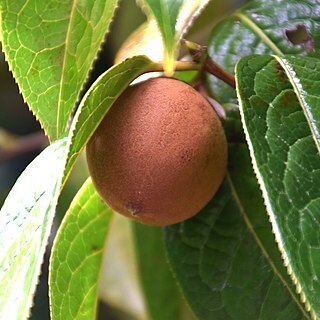Shrubs or trees, 3-8 m tall. Young branches grayish brown; current year branchlets purplish brown, gray pubescent. Petiole 6-13 mm, abaxially pubescent; leaf blade elliptic, oblong-elliptic, narrowly oblong, or lanceolate, 8-14 × (1.5-)2-5(-6) cm, leathery to thickly leathery, abaxially pale green and appressed pubescent, adaxially dark green, shiny, rugulose, and glabrous, midvein abaxially elevated and adaxially level or slightly raised, secondary veins 7-9 on each side of midvein, secondary and reticulate veins abaxially raised and adaxially strongly impressed, base broadly cuneate to rounded, margin pectinately serrulate, apex abruptly shortly caudate to long caudate. Flowers subterminal, solitary, 5-6(-8) cm in diam., subsessile. Bracteoles and sepals ca. 15, ± persistent in young fruit, leathery, margin membranous; outer 4-6 bracteoles and sepals semiorbicular, 2.5-6 mm, outside glabrous or glabrescent; inner bracteoles and sepals orbicular to broadly obovate, 1.2-2(-2.5) cm, outside white or grayish yellow velutinous, inside glabrous. Petals 6 or 7, rose or rarely white; outer 1 or 2 petals distinct, obovate, ca. 2 × 1.5 cm; inner 5 petals broadly obovate, 3-4 × 2.5-3.5 cm, basally connate for 5-8 mm, apex emarginate. Stamens 2.5-3 cm; filaments white villous; outer filament whorl basally connate for 1.5-2 cm. Ovary globose, white velutinous or basally glabrous and apically with pubescence, 3-loculed; style 2-2.5 cm, glabrous or basally white velutinous, apically 3-lobed. Capsule globose, 6-8(-10) cm in diam., 3-loculed with 2 or 3 seeds per locule, apex convex; pericarp ca. l cm when dry, woody, furfuraceous. Seeds brown, semiglobose, 1-1.5 cm in diam. Fl. Jan-Feb, fr. Sep-Oct. 2n = 30*.
More
A small tree. It grows 8 m high. The leaves are leathery. They are oblong and 8-14 cm long by 3-6 cm wide. They have fine teeth along the side. The flowers occur singly and are rose-pink. They are 5-10 cm across. The fruit are capsules 5-10 cm across. The seeds are brown and 1-1.5 cm across.
Can be grown by cuttings or seedlings. Seeds needs soaking.


